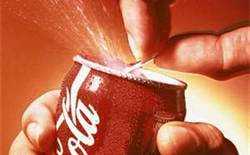When something’s not easy to do, you are doing it wrong
3 minsIt was early days for me at the University of Houston campus in the Fall of 1992. One of my initial starry-eyed memories was that of purchasing my first Coke can from a vending machine on my way back to the Cambridge Oaks apartment. This was my first-ever encounter with a Coke can (for that matter any soft drink can). I examined it as one would a hard-earned trophy. It was chilled to the perfect temperature, the bright red Coke colors and the calligraphic lettering epitomized to me excellence, beauty and perfection — all things I associated with the American Dream that I was here to pursue. And I had just bought it for 60 cents. It was thrilling.
At this point, most normal people would have pushed the tab open and started glugging away. For some odd reason (daftness perhaps?), I decided that one had to twist/rotate the tab (step #1) and then pull the tab (step #2). Not surprisingly, after I had executed step #2, I was left holding a detached tab and a (still unopened) Coke can and feeling rather silly. I hurried my way back back to the apartment with a mixture of how_could_I_be_so_dumb and a steely resolve to make amends. Later in the kitchen, a few deliberate pokes with a screwdriver yielded results and I was soon slaking my Coke thirst. This was incident #1.
Incident #2 involved the American matchbook – which is quite different from its Indian counterpart (which we call “match box” or “matches”). For the benefit of my Indian readers, let me describe the American matchbook – 2 rows of soft matchsticks are fused inside a thin cardboard flap, there’s only striking surface which is on the outer side of the flap. In case you are wondering, I’ve been a smoker for a grand total of 3 1/2 years – the latter 2 years were during my 1992-94 Houston stint. My roommate (another smoker from India) and I used the matchbook like an Indian matchbox – i.e. tear off the soft stick, and strike it against the striking surface. After a few days of low hit-rate match-strikes, we concluded that the Americans didn’t know how to manufacture matchbooks. Along comes Beaumont-Srini (a senior in Business school) who showed us the correct way of using the American matchbook — twist the flap around to almost touch the striking surface and simply pull out the match between the striking surface and the flap. Voila! (Friction + chemistry = fire).
As I reflected on these 2 incidents, our mutual good friend, philosopher, guide and senior – Soumya (of Soumya.org fame) had this pithy summary about life in America: when something’s not easy to do, you are doing it wrong. Over the years, this served as a reliable guiding litmus test. When I found myself waiting for hours at the DMV, turns out I could have called a toll free number to book an appointment instead. Years later, when I kept getting placed on hold on that toll free DMV number, turns out I could have booked my appointment (via the web) in less than a minute.
Now let’s look at India. The same pithy litmus test can be applied here – you just have to flip it on its head: when something’s looking very easy, you are probably doing it the wrong way. If you got your driver’s license in a single afternoon, chances are you bribed the RTO officer or utilized the services of a driving school agent. If you bought the latest video game or the newest Bollywood release from a footpath vendor as you were lounging down Indiranagar’s 100-feet road or Koramangala’s 80-feet road, they were definitely pirated (and you knew it!). If it’s taking you fifteen visits to the Corporation office to register your recently purchased property and you still don’t know when it will finally be registered, you (my friend) are doing it the right way!
If you found my description of the American matchbook to be inadequate, here are some visuals via Google Images: click here
